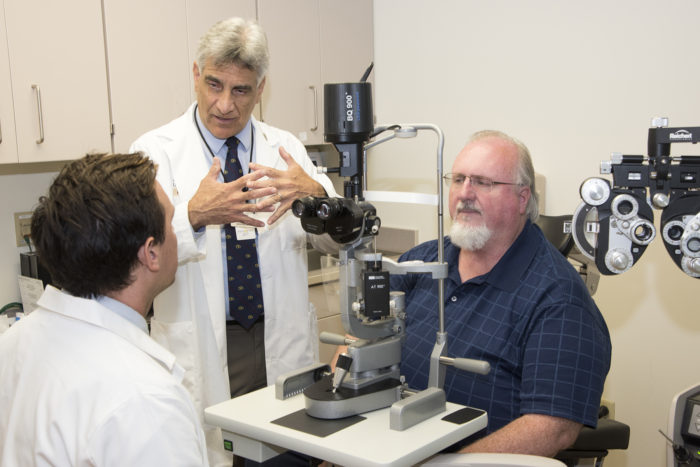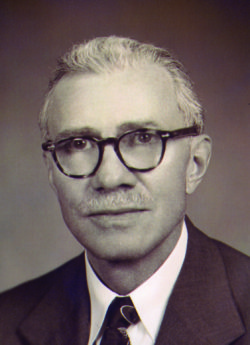Ophthalmology department renamed in honor of John F. Hardesty
$10 million from daughter to fund research, patient care and recognize legacy
 Robert Boston
Robert BostonTodd P. Margolis, MD, PhD, (center) head of the newly named John F. Hardesty, MD, Department of Ophthalmology and Visual Sciences at Washington University School of Medicine in St. Louis, talks with ophthalmology resident Joel R. Palko, MD (left), as they examine patient Michael Jackson. The department's new name stems from a $10 million gift from Hardesty's daughter, Jane Hardesty Poole.
Thanks to a major gift from a Washington University alumna, the Department of Ophthalmology and Visual Sciences at Washington University School of Medicine in St. Louis will be known as the John F. Hardesty, MD, Department of Ophthalmology and Visual Sciences.
The $10 million gift will support basic vision research and translational research to help take those research findings into clinical practice. The funds also will help provide vision care for patients, including those in financial need. In addition, the gift will support the recruitment and retention of leading physician-scientists as department faculty.
“This extraordinary gift will enable our vision researchers and clinicians to continue their great work and to build on an already extraordinary history of discovery and treatment of diseases that continue to rob sight from millions of people all over the world,” said Washington University Chancellor Mark S. Wrighton. “And we are delighted that Jane Hardesty Poole has chosen this way to honor her father, who was himself a pioneer in the understanding and treatment of glaucoma.”
Hardesty (1887-1953) was a St. Louis ophthalmologist, teacher, writer and war hero whose heritage may be traced back to colonial and early Missouri settlers. He earned bachelor’s and medical degrees simultaneously from Saint Louis University (SLU) in 1914. Later, he enlisted in the U.S. Army and served on the front lines in World War I, before joining the faculty at SLU School of Medicine.
His daughter, Jane Hardesty Poole, endowed the new gift to honor her father. Poole, a 1961 graduate of Washington University, previously had established the John F. Hardesty, MD, Distinguished Professorship in Ophthalmology and Visual Sciences, also in his honor. That endowed professorship is held by pediatric ophthalmologist Lawrence Tychsen, MD, who also is a professor of pediatrics and of neuroscience.
“This gift recognizes both an outstanding department and an outstanding physician-scientist,” said David H. Perlmutter, MD, executive vice chancellor for medical affairs and dean of Washington University School of Medicine. “For decades, the department has been recognized as a leader in the visual sciences, and with Todd Margolis at the helm the past 3½ years, it has continued to make outstanding contributions in the areas of research and clinical care. This unrestricted gift from Jane Hardesty Poole will allow the department to continue its tradition of excellence.”
The department, founded in 1928, consists of 41 full-time faculty members, including 16 clinicians who practice at 16 different office locations, and 25 MD or PhD researchers. Later this year, the department will move its primary clinical operations to the Center for Outpatient Health on the north side of the Washington University Medical Campus. To celebrate the new name, in 2018 the department will host a vision research symposium for physicians and scientists from many of the world’s leading medical institutions.
“Our department has a long history of advancing the understanding of eye diseases and vision loss, particularly in the area of glaucoma,” said Todd P. Margolis, MD, PhD, the Alan A. and Edith L. Wolff Distinguished Professor and head of the ophthalmology department. “So it is fitting that our department now will bear the name of a man whose life’s work involved preserving vision and improving quality of life for glaucoma patients.”

After graduating from medical school, Hardesty spent two years as an intern and then resident at St. Louis City Hospital. He then enlisted in the U.S. Army Medical Corps and was transferred, at his own request, to the Seaforth Highlanders in the British Military Service.
He served on the front lines of World War I until March 1918, when he was captured by the German army and held for eight months, serving most of that time at prisoner-of-war camps in Rastatt and Villingen, Germany. While at the Villingen camp, he devised a plan that led to the successful escape of three fellow prisoners in October 1918. Hardesty’s role in that effort was widely reported in newspapers after he was formally discharged from the army in 1919 with the rank of captain.
Hardesty joined the SLU School of Medicine faculty in 1920 and served as an associate professor from 1934 to 1953. He also was the acting chair of the school’s ophthalmology department from 1950 to 1953.
In 1934, he wrote a pioneering thesis for membership in the American Ophthalmological Society titled “Treatment of Glaucoma by Systemic Measures.” Although the earliest recorded treatments of glaucoma date back to the mid-19th century, Hardesty’s research involved treating the disease with medications given systemically. His were the first attempts to treat glaucoma in this manner, and Hardesty’s idea to use epinephrine to treat glaucoma is still practiced today. His work laid the foundation for the development of the drug Diamox (acetazolamide) in the 1950s by Bernard F. Becker, MD, former head of Washington University’s ophthalmology department.
In addition to his university duties, Hardesty was a practicing ophthalmologist at the St. Louis City Sanitarium from 1921 to 1953 and ophthalmologist-in-chief at Missouri Baptist and Bethesda General hospitals. He also was a member of the Medical Advisory Board for the state of Missouri and served as a medical director for the St. Louis Society for the Blind. He provided free eye care to residents of the Blind Girls’ Home in St. Louis, the Missouri School for the Blind and other schools and orphanages, as well as patients throughout the region during the course of his long career. He also was a recipient of the Robert Johnson Prize for research on the causes of blindness in Missouri.
His daughter, Jane Hardesty Poole, said that in making the gift, she wishes to honor her father’s distinguished service to his profession and his deep commitment to patients and families affected by vision loss.
“My father exemplified the best of what a doctor should be,” Poole said. “On top of his great ability, he was caring and was generous with his time, talent and resources. I am delighted to be able to honor his memory in a way that will advance the important work taking place in the department and ensure exceptional care for patients and families.”







